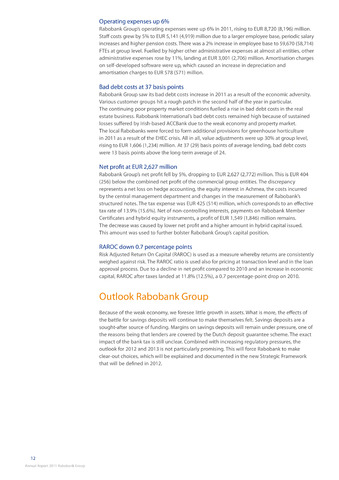Outlook Rabobank Group
Operating expenses up 6%
Rabobank Group's operating expenses were up 6% in 2011, rising to EUR 8,720 (8,196) million.
Staff costs grew by 5% to EUR 5,141 (4,919) million due to a larger employee base, periodic salary
increases and higher pension costs.There was a 2% increase in employee base to 59,670 (58,714)
FTEs at group level. Fuelled by higher other administrative expenses at almost all entities, other
administrative expenses rose by 11%, landing at EUR 3,001 (2,706) million. Amortisation charges
on self-developed software were up, which caused an increase in depreciation and
amortisation charges to EUR 578 (571) million.
Bad debt costs at 37 basis points
Rabobank Group saw its bad debt costs increase in 2011 as a result of the economic adversity.
Various customer groups hit a rough patch in the second half of the year in particular.
The continuing poor property market conditions fuelled a rise in bad debt costs in the real
estate business. Rabobank International's bad debt costs remained high because of sustained
losses suffered by Irish-based ACCBank due to the weak economy and property market.
The local Rabobanks were forced to form additional provisions for greenhouse horticulture
in 2011 as a result of the EFHEC crisis. All in all, value adjustments were up 30% at group level,
rising to EUR 1,606 (1,234) million. At 37 (29) basis points of average lending, bad debt costs
were 13 basis points above the long-term average of 24.
Net profit at EUR 2,627 million
Rabobank Group's net profit fell by 5%, dropping to EUR 2,627 (2,772) million. This is EUR 404
(256) below the combined net profit of the commercial group entities. The discrepancy
represents a net loss on hedge accounting, the equity interest in Achmea, the costs incurred
by the central management department and changes in the measurement of Rabobank's
structured notes.The tax expense was EUR 425 (514) million, which corresponds to an effective
tax rate of 13.9% (15.6%). Net of non-controlling interests, payments on Rabobank Member
Certificates and hybrid equity instruments, a profit of EUR 1,549 (1,846) million remains.
The decrease was caused by lower net profit and a higher amount in hybrid capital issued.
This amount was used to further bolster Rabobank Group's capital position.
RAROC down 0.7 percentage points
Risk Adjusted Return On Capital (RAROC) is used as a measure whereby returns are consistently
weighed against risk.The RAROC ratio is used also for pricing at transaction level and in the loan
approval process. Due to a decline in net profit compared to 2010 and an increase in economic
capital, RAROC after taxes landed at 11.8% (12.5%), a 0.7 percentage-point drop on 2010.
Because of the weak economy, we foresee little growth in assets. What is more, the effects of
the battle for savings deposits will continue to make themselves felt. Savings deposits are a
sought-after source of funding. Margins on savings deposits will remain under pressure, one of
the reasons being that lenders are covered by the Dutch deposit guarantee scheme.The exact
impact of the bank tax is still unclear. Combined with increasing regulatory pressures, the
outlook for 2012 and 2013 is not particularly promising. This will force Rabobank to make
clear-out choices, which will be explained and documented in the new Strategic Framework
that will be defined in 2012.
12
Annual Report 2011 Rabobank Group

